My first encounter with Australian birds some years ago was of shear fascination of names the birds are being known to be called.
Bird field guide books have names to substantiate their apt description, be it their behaviour, bird calls or simply in anatomical description, habitat or their eating habits.
Readers would rightly have guessed who they are, by mere hearing or be looking at by the mention of Catbird, Butcherbird, Lyrebird, Riflebird, Cicadabird, Bellbird, Bowerbird, Friarbird, Logrunner, Frogmouth, Apostle bird, Pink-eared Duck, Spoonbill, Oystercatcher, Chiming Wedgebill, the ubiquitous Laughing Kookaburra and quaint names like Hardhead, Thick-knee, Diamond Firetail, etc.. from an impressive and updated full checklist of close to 900 bird species in Australia.
Willie Wagtail (Rhipidura leucophrys), a species belonging to the Rhipidura family of fantails is the chosen species of good description in behaviour for being the most co-operative and easily seen bird to be featured for this write up (above).
Being restless and always on the move, either to hawk for insects on the ground or frolicking during their breeding season, Willie would sway its black plumaged body and tail side to side when standing still (above).
This movement behaviour differs from other bird species that usually cork their tails and fan them in an up, down movement.
Another interesting feature of the Willie Wagtail is the black and white plumage on the throat and breast that forms a breast-band, is arched like a rainbow-a reversal of other smaller fantail species (below left).
The image (above centre) shows Chinese opera looking slit, white eye brows or supercilium. They apparently vary in size with level of excitement. I am yet to check this observation out the next visit. The primaries have brown highlights that shimmer when sunrays hit at the right angle.
Perching at 19-22cm in size, with a lively and musical chattering call, this black and white bird with total black feet has an innate look as captured in image above (rignt) is known to exhibit aggressive behaviour towards other birds.
AVIAN WRITER DAISY O’NEILL PENANG MALAYSIA
© ‘WILLIE’ THE WAGTAIL


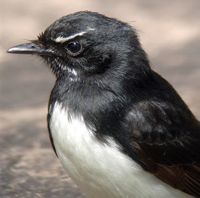
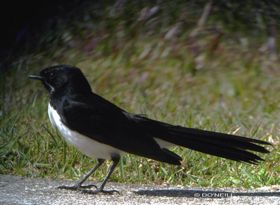
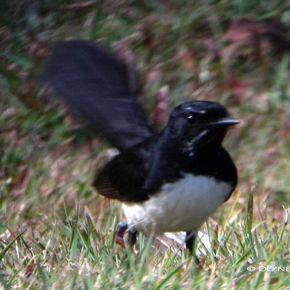

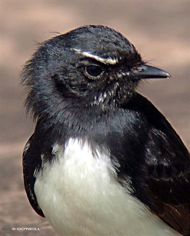
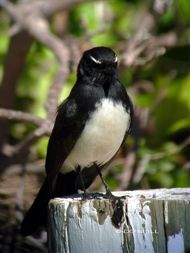
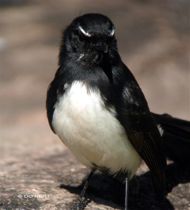







One Response